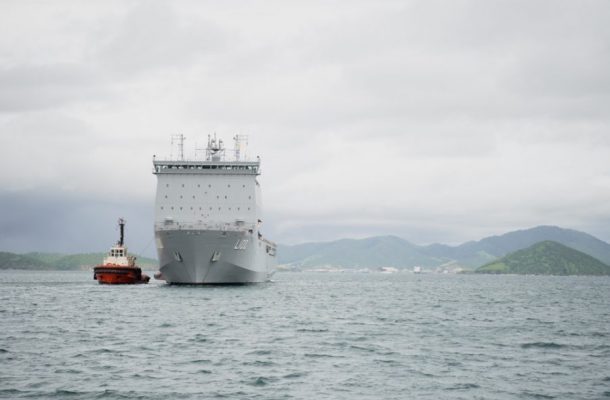Australia’s evolving guarantee to the South Pacific

It’s hard to believe these days, but Australia used to be shy about proclaiming a defence or security guarantee to Papua New Guinea and the South Pacific.
In the 1970s and 1980s, a gap opened between secret defence guidance about Australia’s determination to fight for the island arc and what Canberra said to the new nations of the arc.
Well into the 1990s, Australia promised to do its bit so South Pacific states could ‘look after their own strategic interests’; in a crisis, the focus of the Oz military would be ‘evacuation of Australian citizens’.
The mindset was crammed into one phrase by Ashton Calvert (secretary of the Department of Foreign Affairs and Trade from 1998 to 2005), who remarked to me that Australia’s policy in the South Pacific was ‘to intelligently manage trouble’. Australia would stand ready but stand back, keeping its hands off.
The mindset has changed remarkably. Canberra’s ambitions have grown, as has the need.
The depth and geographic reach of Australia’s guarantee expanded, evolving outwards from PNG to cover the whole of the South Pacific and Timor-Leste. That growth matched the development of international relations thinking beyond state security.
Australia’s pledge to the islands today is as much about internal security—human, economic, political and environmental—as defence against external threats.
Because Canberra’s South Pacific view is always framed by PNG, the gap between Oz secret strategy and public statements in the 1970s and 1980s had a PNG foundation.
No longer the colonial master, Australia was discovering how to deal with an independent neighbour, just as it had to build understandings with other newly independent island states. A Canberra element was to shift the secretive habits of Australia’s Defence Department: some core interests are so important they need to be publicly stated.
To see how this once operated, come to a meeting in 1985 between Indonesia’s defence minister, General Benny Murdani, and Australia’s defence minister, Kim Beazley. Murdani asked the extent of Australia’s military commitment to PNG. Beazley replied: ‘First, you need to understand that we would fight for PNG to the last Australian soldier. We have done it before. Second, we would never be as emphatic in our expression of that to the PNG government in case they decided to test it.’
Beazley was telling Murdani that Australia would go to war to defend PNG’s border against Indonesian incursion. That danger was real because the rebel Free Papua Movement was using bases in PNG to operate in Irian Jaya.
Angered at Port Moresby’s ‘connivance’, Jakarta made military plans to cross the PNG border in force to destroy rebel camps. The secret version of the 1986 Review of Australia’s defence capabilities feared Indonesian troops would stay in PNG permanently to ‘occupy the border region to some depth’.
Knowing it’d fight for PNG, Australia decided to stop worrying about PNG testing a guarantee. Don’t ask, don’t tell was too dangerous a policy. Stop worrying about ‘moral hazard’ (PNG could take risks because Australia would carry the cost if things went badly) and just focus on the hazard. Time to give formal expression to Australia’s willingness to defend PNG.
Beazley later said the Indonesia border issue was one reason Australia needed to formalise the PNG defence relationship within a broad 1987 treaty: ‘The purpose in part was to discourage Indonesia from doing anything in PNG and in part for us to get a handle on what the PNG government was doing.’
The 1987 joint declaration of principles on Australia–PNG relations pointed to ‘unique historical links and shared strategic interests’. It stated: ‘In the event of external armed attack threatening the national sovereignty of either country, such consultation would be conducted for the purpose of each Government deciding what measures should be taken, jointly or separately, in relation to that attack.’
Australia’s pledge to fight for PNG didn’t have any ANZUS-style reservations (‘acting in accordance with its constitutional principles’). The guarantee had to be part of a general declaration of principles because Canberra and Port Moresby couldn’t agree on the terms of a separate defence treaty. A certain principled vagueness was retained, but the fog was clearing.
A decade later, in 1997, the Howard government’s strategic policy described Australia’s ‘compelling’ interests in PNG and readiness ‘to commit forces to resist external aggression’. For the first time, the unclassified document expanded the PNG guarantee to make it a Melanesian pledge, with the ‘same considerations that apply to PNG’ also covering Solomon Islands and Vanuatu.
Having given a PNG-level promise to Melanesia, the 1997 statement then embraced the whole of the Pacific Islands Forum, recognising that ‘any attack on them—or penetration by a potentially hostile power—would be serious for our security and that, as with PNG, we would very likely provide substantial support in the unlikely event that any of them faced aggression from outside the region’.
What Australia could hardly say officially to PNG in the 1980s it was now affirming to the whole of the South Pacific. Timor-Leste was soon added.
In 1999, Australia led the UN into East Timor to protect the independence vote. For the Australian cabinet, the new reality was that ‘our long-term interests in East Timor’s security and territorial integrity’ amounted to another security IOU.
In learning by doing, Canberra has come to understand that its guarantees have economic and political meanings as well as military.
We’ve worked out you can’t have an exit strategy from your own region: as Solomon Islands teetered towards disaster in 2000, Canberra rejected a request for 50 Australian police (no exit strategy!) and sent a navy ship to evacuate Australians from Honiara, a moment of panicked exit not policy commitment.
The region—not just Australia—draws much from the peace process in Bougainville and the 14-year Regional Assistance Mission to Solomon Islands.
Australia’s Pacific pivot is an external defence guarantee and an internal promise to the South Pacific and Timor-Leste: offering economic and security ‘integration’ to uphold the region by holding it closer.
China’s challenge is the pivot headline, yet many previous Australian steps lead to the Pacific step-up.
Canberra’s worry these days isn’t the moral hazard of its pledge. It’s more that the South Pacific takes the guarantee for granted—as a mere statement of Australian interests—and that it doesn’t carry enough weight in island policy choices.
This article was published by The Strategist.

Graeme Dobell has been reporting on Australian and international politics, foreign affairs and defence, and the Asia Pacific since 1975. He is Journalist Fellow at the Australian Strategic Policy Institute.














